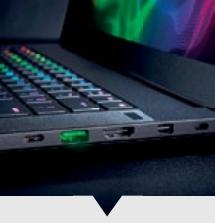Razer Blade 2018


Razer Blade 2018

Razer is back with a new Blade laptop, and it’s the company’s best looking machine yet. The 2018 Razer Blade is milled from a single block of aluminum, and the result is a sleek, dusky beauty that you can use for both work and play.
The hottest trend in the gaming notebook space right now is probably the push toward ultra-slim bezels, and the 2018 Blade embraces that with gusto. One of my main complaints with Razer Blade laptops, including the Blade Stealth, has been their thick bezels, so this year’s design refresh could not have been more welcome.
The other major change in the Blade’s design language comes in the form of a more angular and blocky look that is reminiscent of the Razer Phone. When set beside the older 14-inch Razer Blade and its rounded corners, there’s no doubt that the sharper edges on the new Blade give it a more modern feel.
However, Razer says that this sharper (literally) look is also a result of the exigencies of a more compact design. This is because the more squared-off corners allow Razer to push components further to the edge of the chassis, making additional room for things like a larger 80Wh battery and a more spacious component layout.
The efficient use of space is important because Razer has put a heavy emphasis reducing the space footprint of the new Blade, so this is one of those 15.6-inch laptops that are closer in size to their 14-inch counterparts.
Razer has checked many of the right boxes with its newest Blade laptop. The 144Hz refresh rate panel is a great inclusion, and compared to a regular 60Hz screen, even the smallest things like mouse movements or dragging a window across the screen feel markedly smoother. In game, the difference is even more palpable, and it’s noticeably easier to aim, flick, and react in every firefight.
But the refresh rate aside, image quality on the Blade’s 1,920 x 1,080-pixel IPS display is also top-notch. Colors really popped for me, and the slim bezels created a more expansive and immersive experience that has been sorely lacking on Razer laptops before this one. Viewing angles were also excellent, as expected of an IPS panel, while the matte finish helps to dull reflections.
However, I found myself running it at 100 per cent brightness most of the time, so it feels like it could do with a brightness boost.
The screen’s top bezel is also markedly thicker than those at the left and right, but it does mean that there’s still room for a webcam there. In the quest for ever slimmer bezels, many manufacturers have had to compromise and relocate the webcam to the bottom bezel, which gives rise to some seriously unflattering camera angles.
If you ask me, a marginally thicker top bezel is a small price to play for a more functional design.
The RGB backlit keyboard is powered by Razer’s Chroma software, and the lighting is bright and even and very pretty to look at. The Chroma configurator provides extensive per-key customization options, and you’ll have a field day tweaking it to suit your preferences.
Another thing I really like is the larger than average Windows Precision Touchpad. At 130 x 80mm, the bigger touchpad complements the notebook’s design quite well, and the larger area obviously provides more usable space and improves the overall experience. The glass-topped touchpad is super smooth, precise, and responsive, with good feedback for the integrated left- and right-click buttons.
But as with all slim designs, cooling is a concern, and Razer says the Blade utilizes vapor chamber technology to keep the laptop cool instead of more conventional heat pipes. It uses this for both the CPU and GPU, and the vacuum- sealed vaporized liquid helps dissipate heat from the other components as well.
That sounds nice in theory, but if you end up gaming without any air conditioning both palm rests can get piping hot, to the point that it becomes uncomfortable to rest your palms on the laptop.
Performance-wise, the new Blade will handle pretty much any game you throw at it at 1080p. This is one of the few gaming laptops that can also double as a work machine, thanks to its tasteful design, good battery life, and excellent trackpad. Furthermore, its svelte dimensions and relatively light weight means that you can easily take this out with you.

The Razer Blade comes with a single Thunderbolt 3 port.

The laptop uses its own magnetic proprietary charging connector.


CONCLUSION
A high-performance gaming laptop that is also quite portable.
PICTURES RAZER























